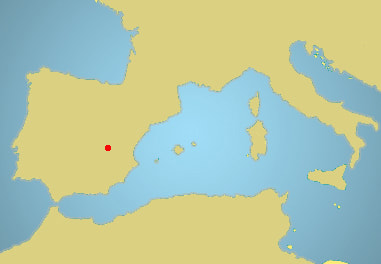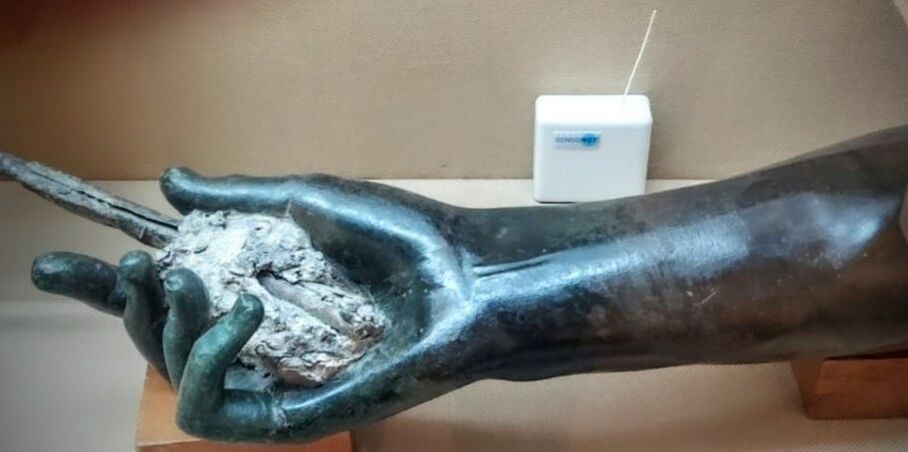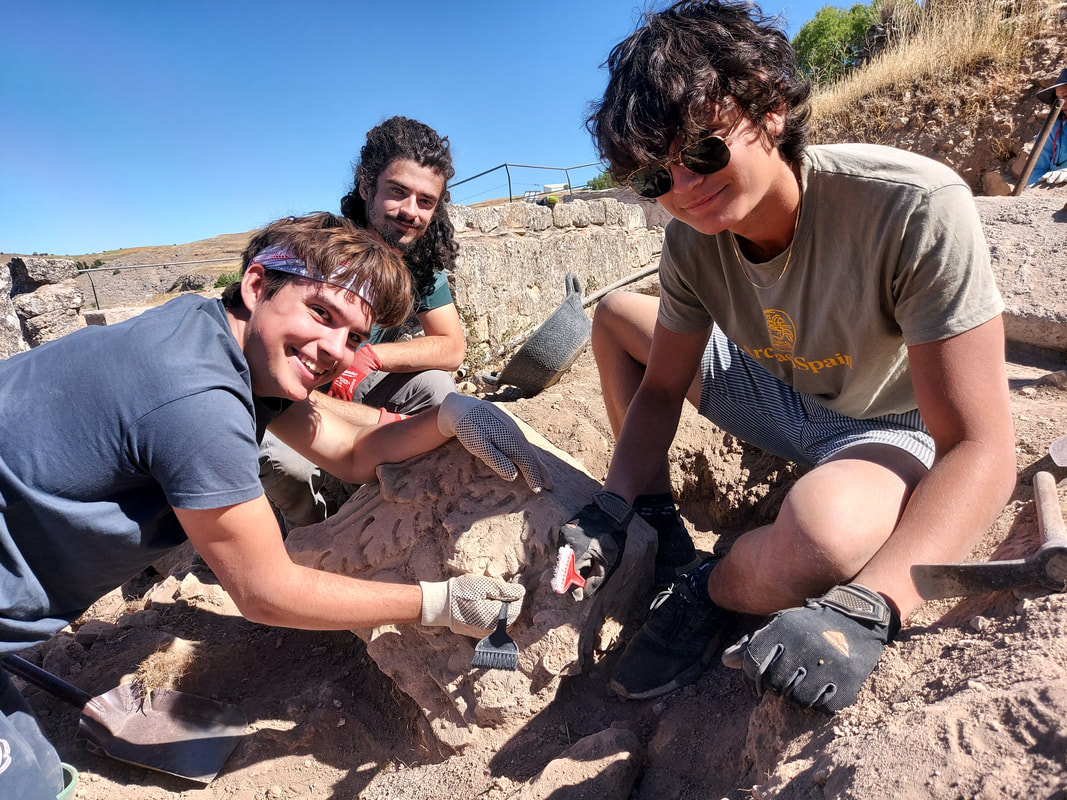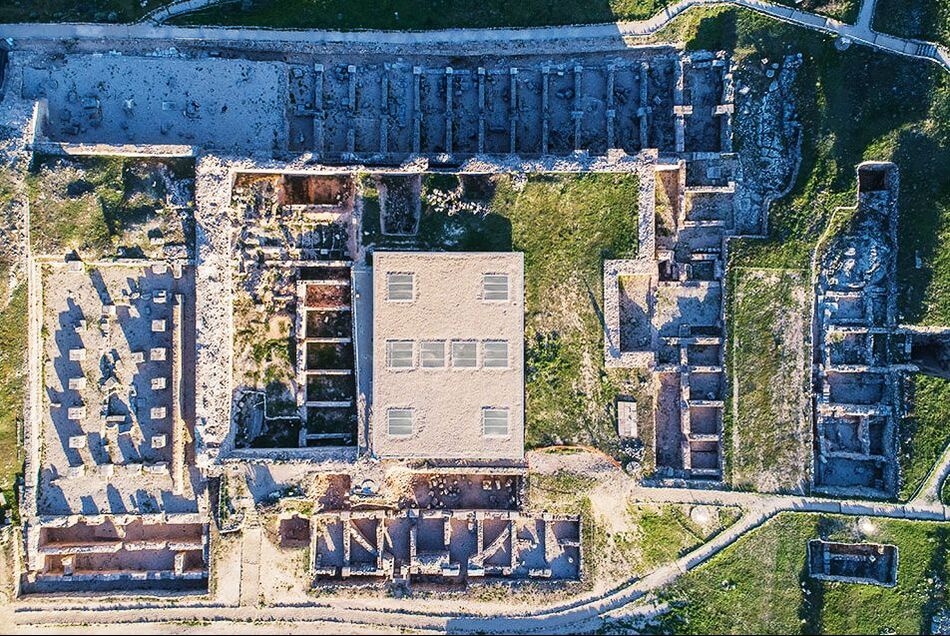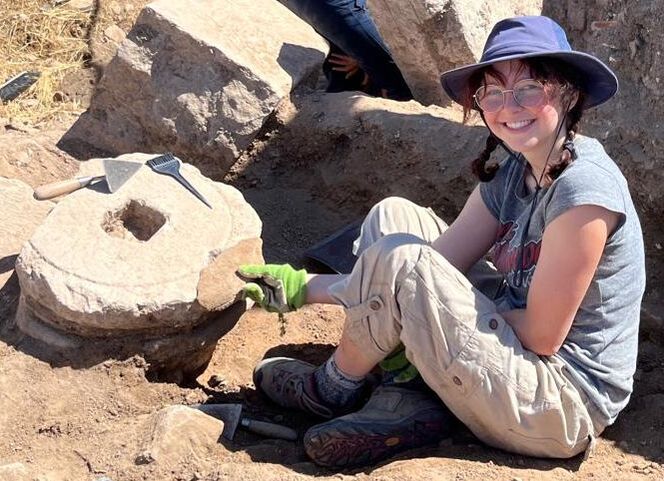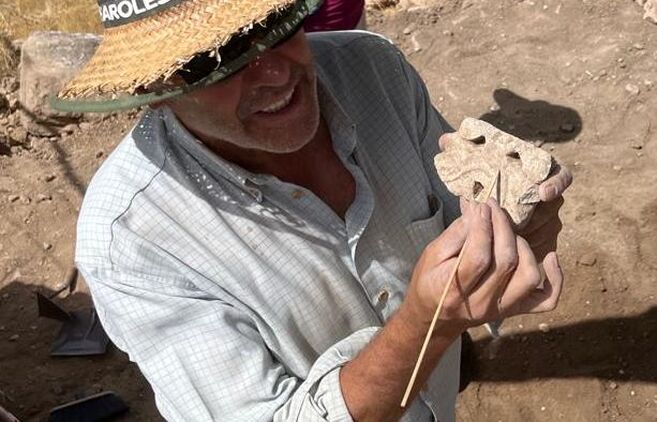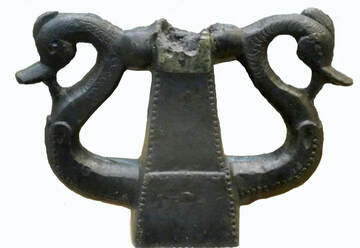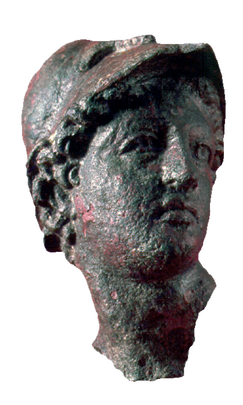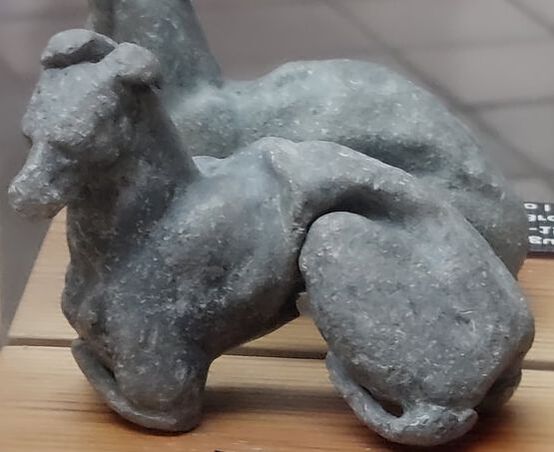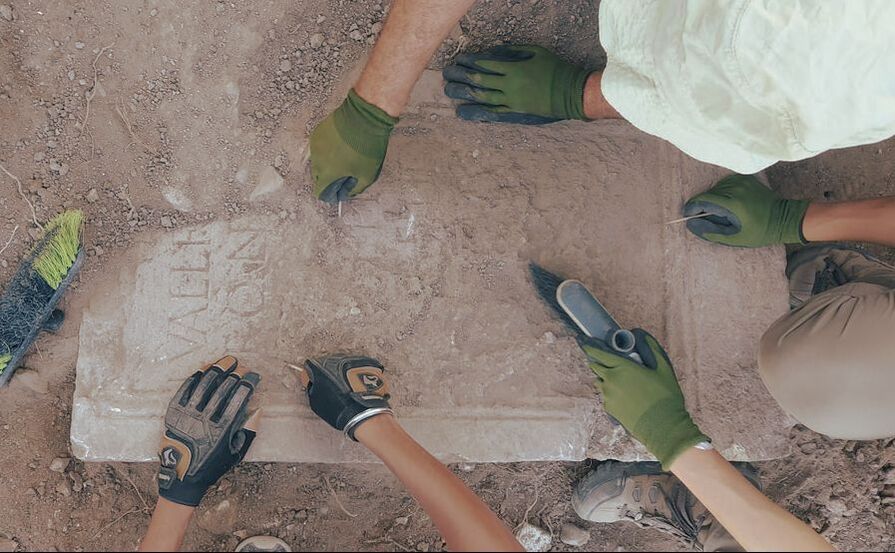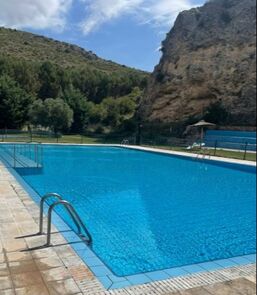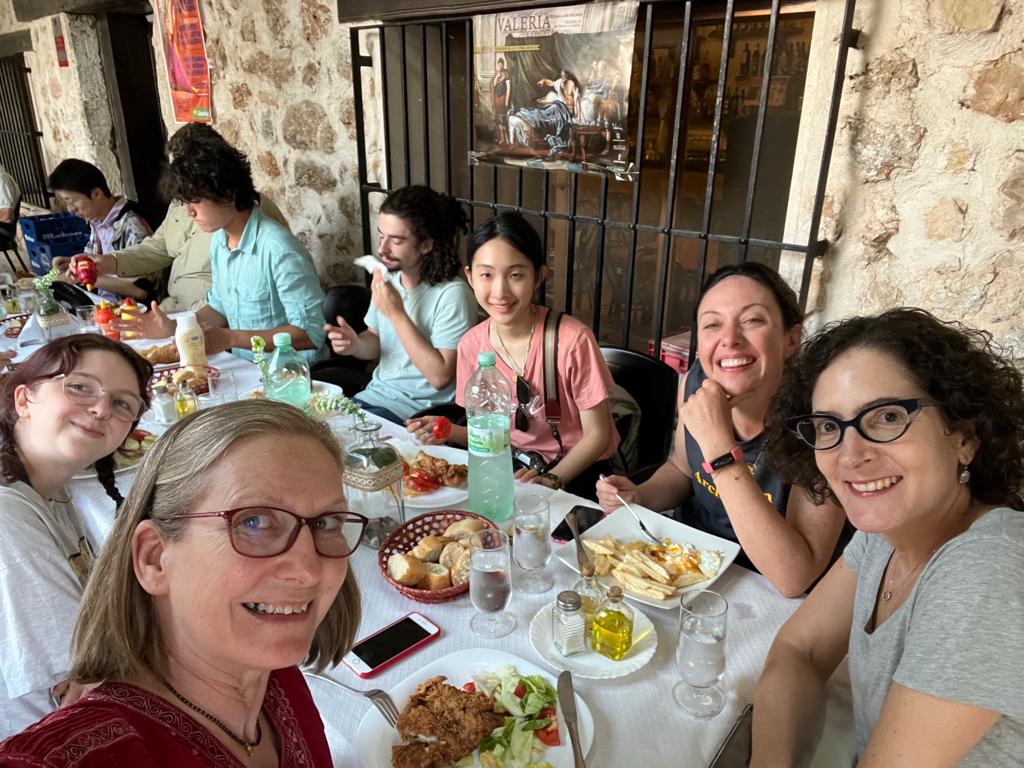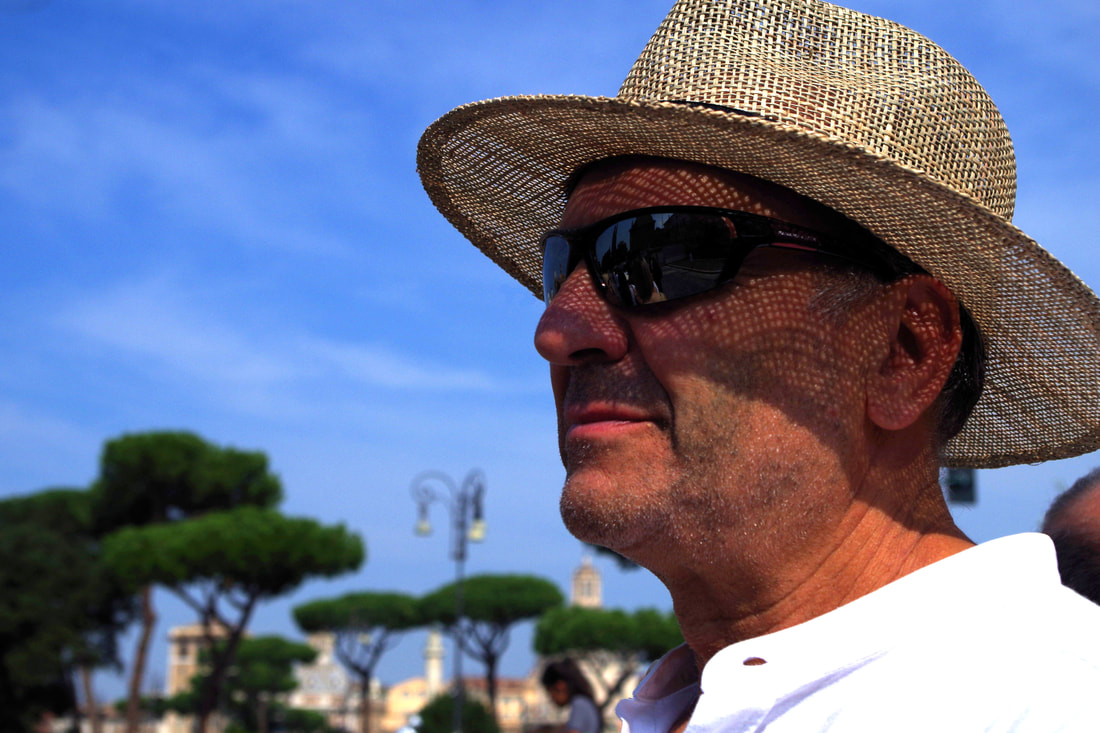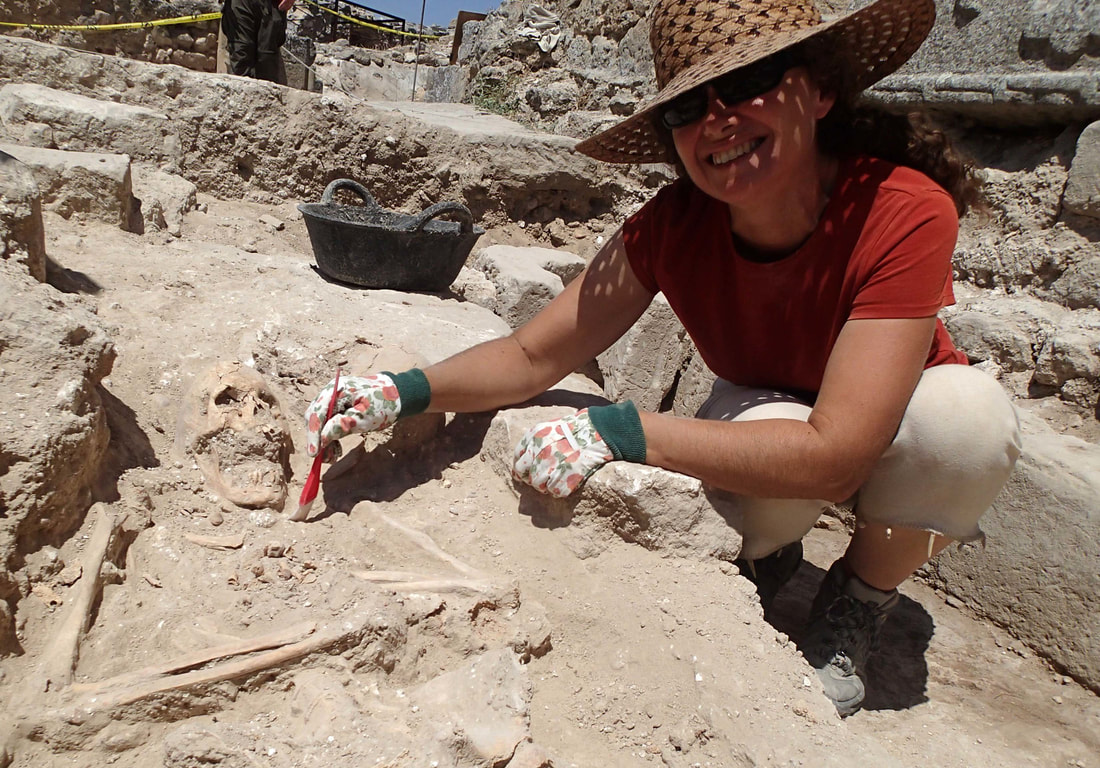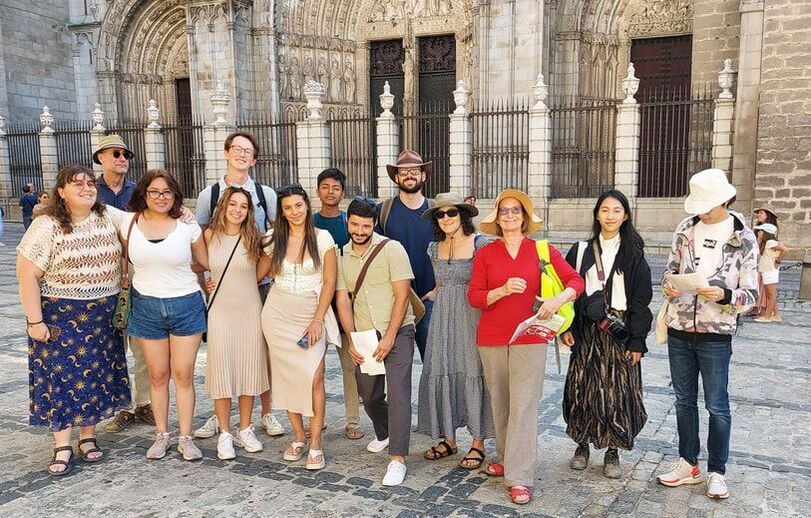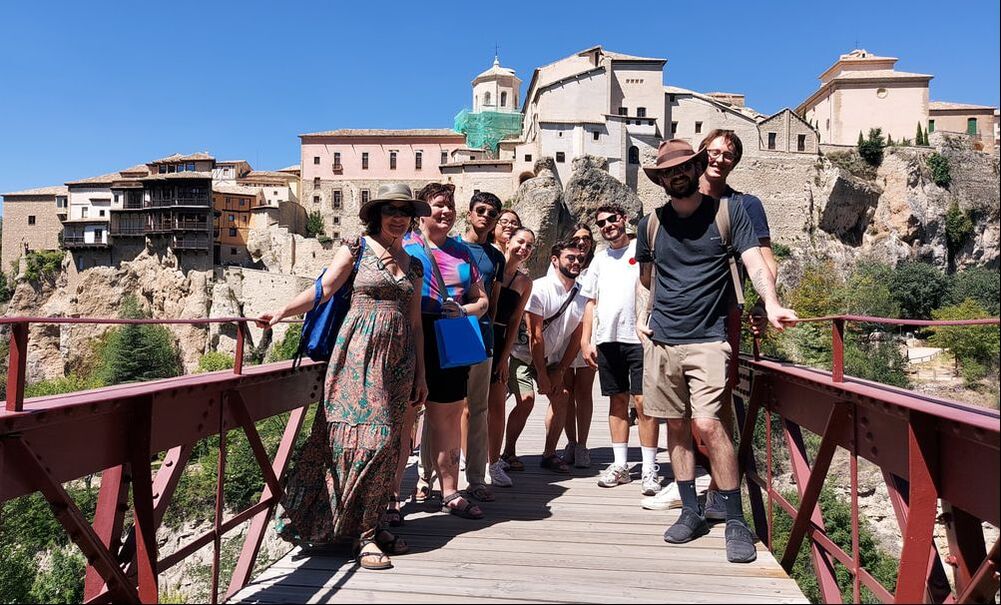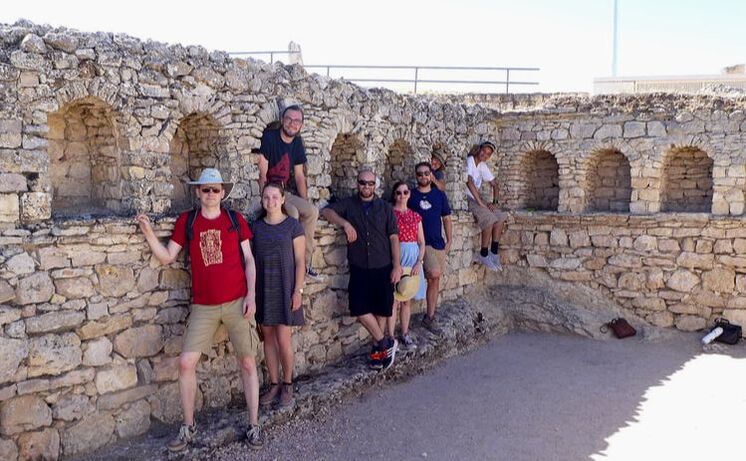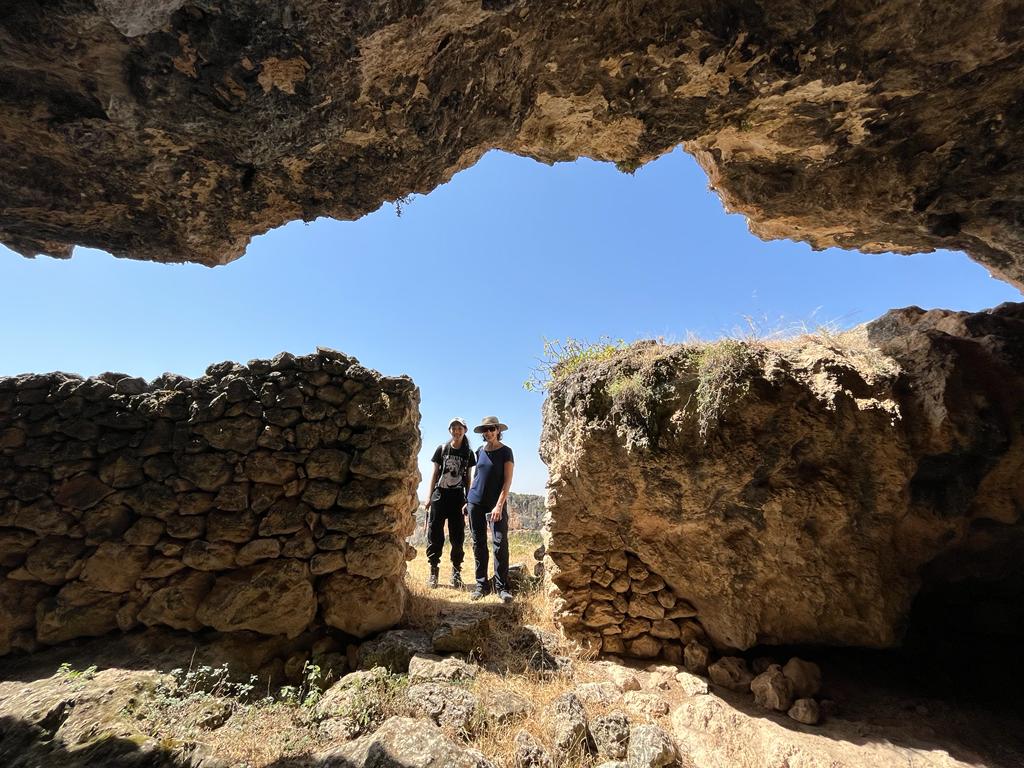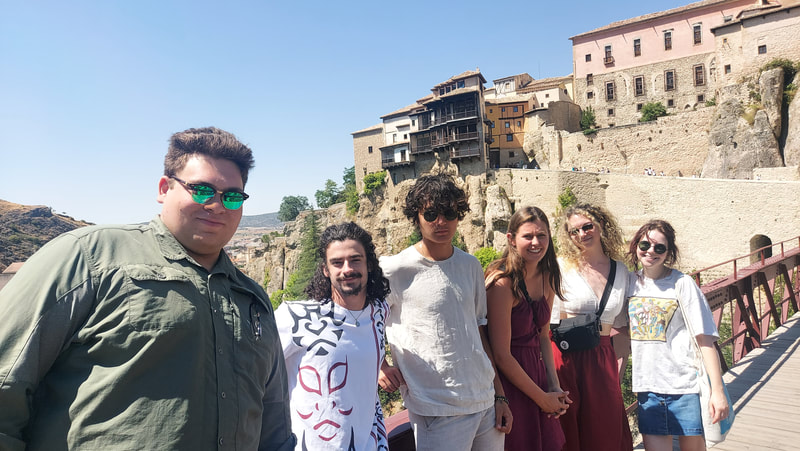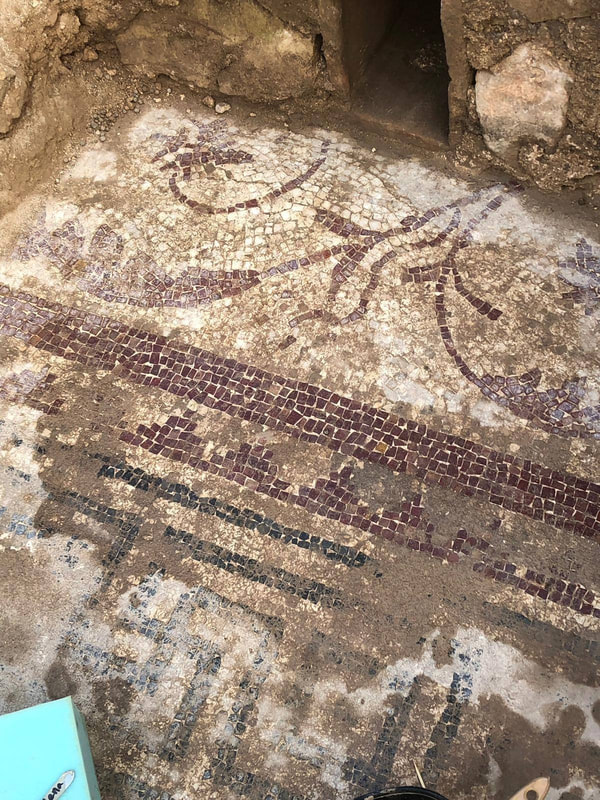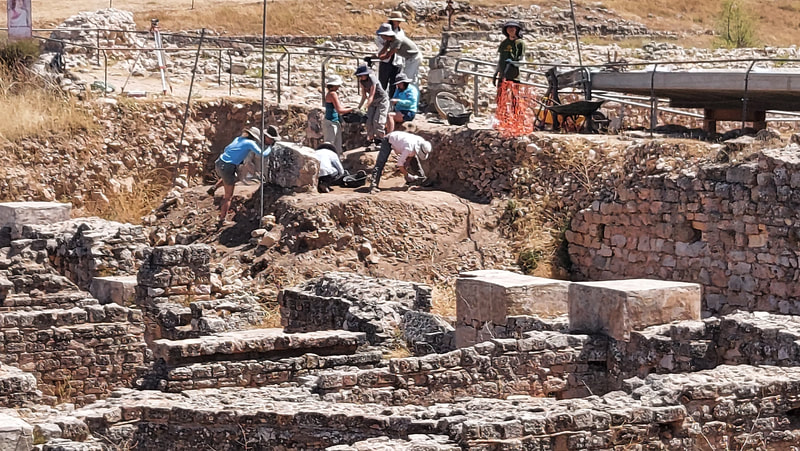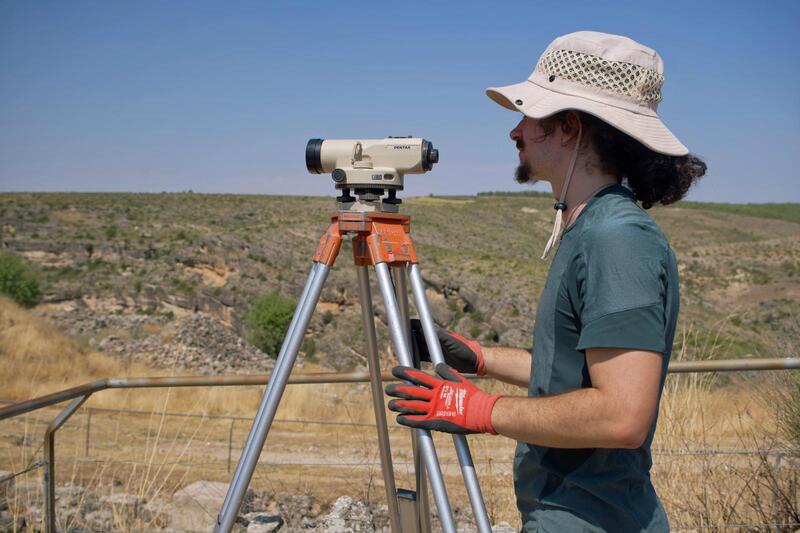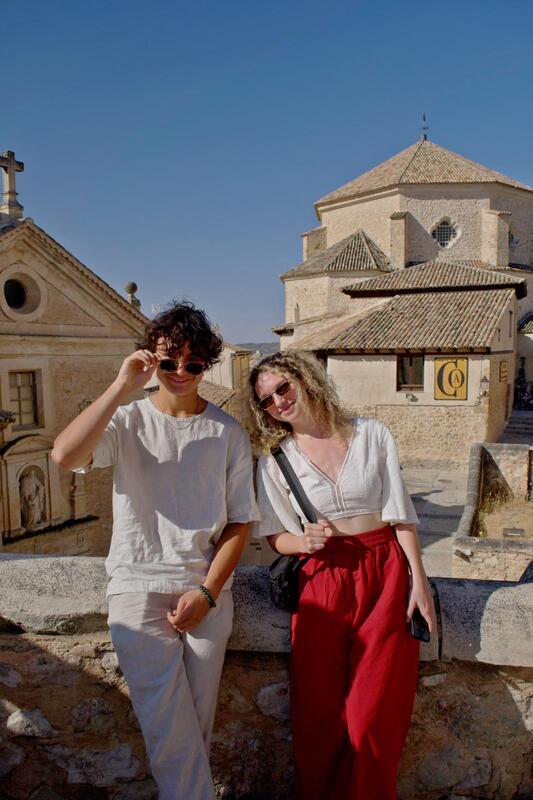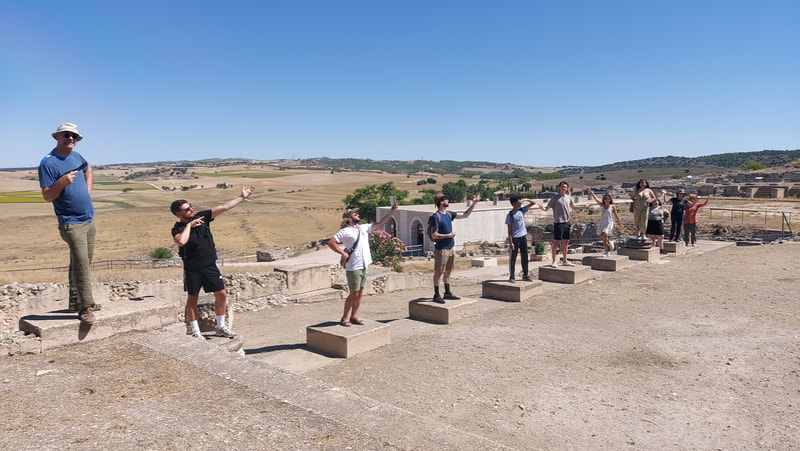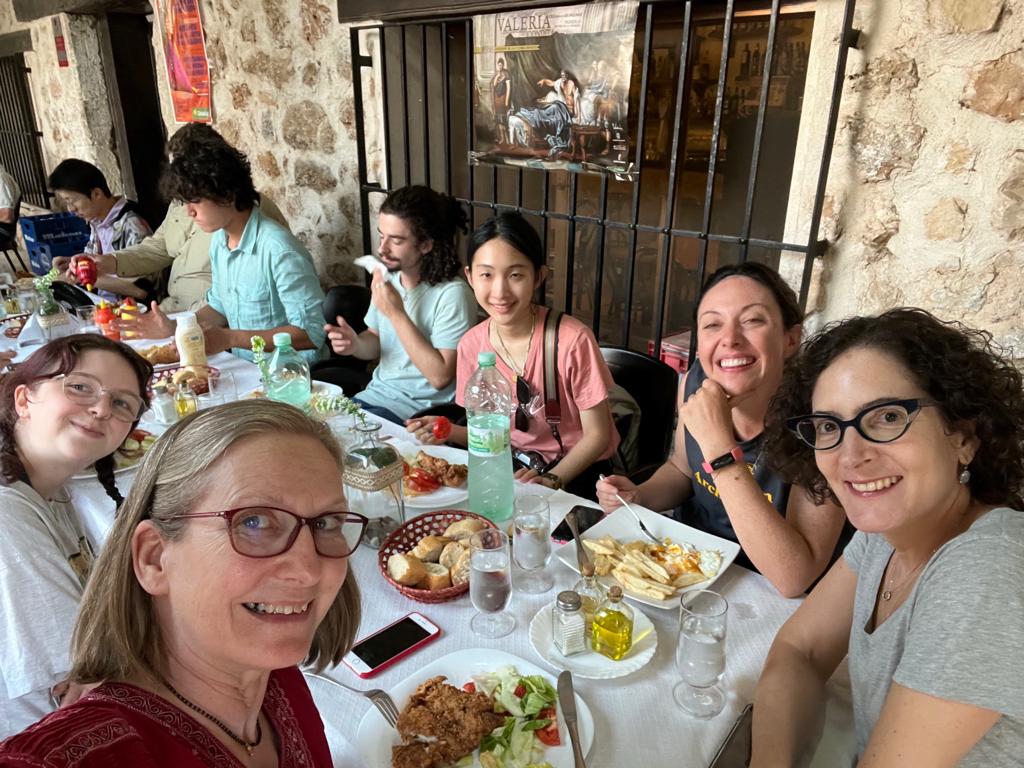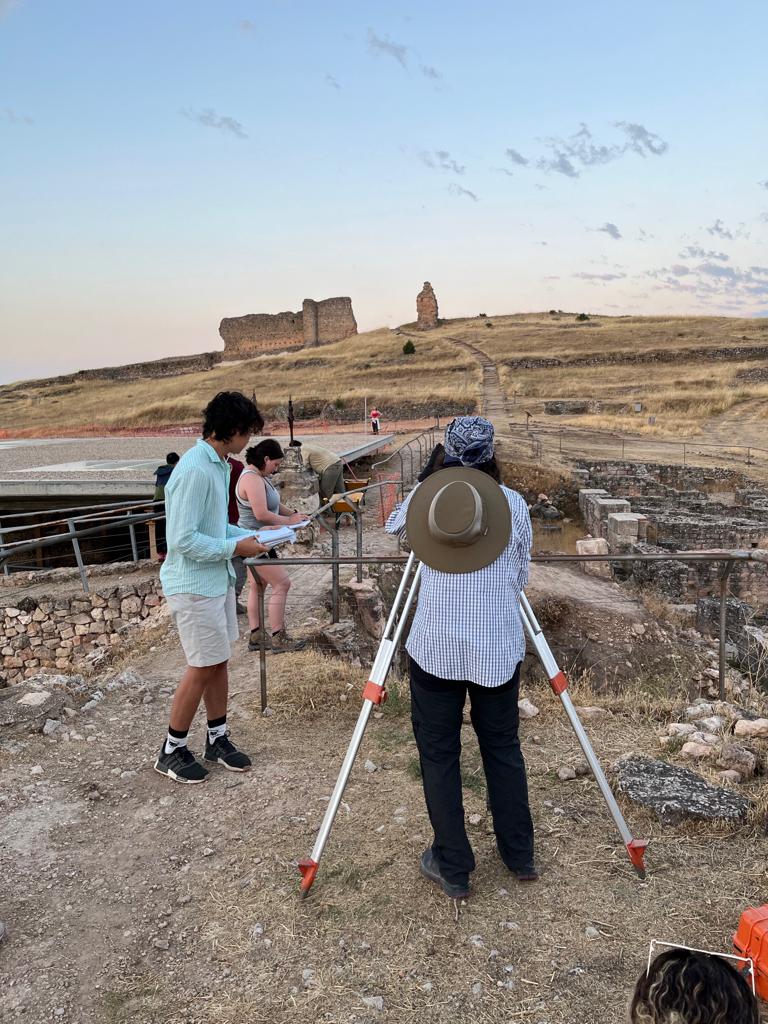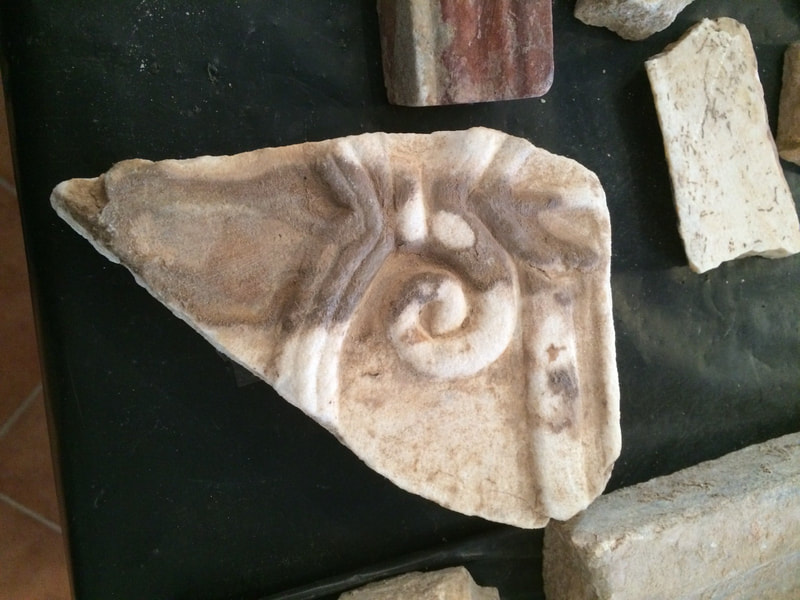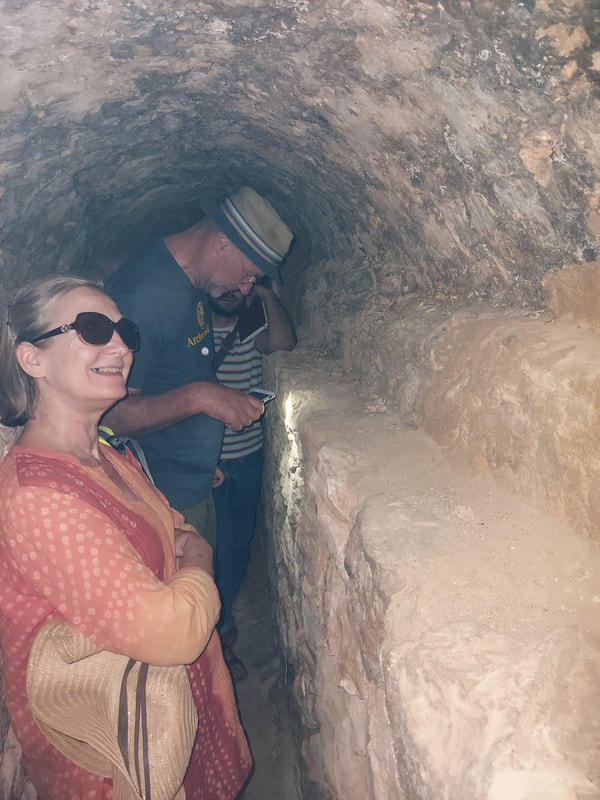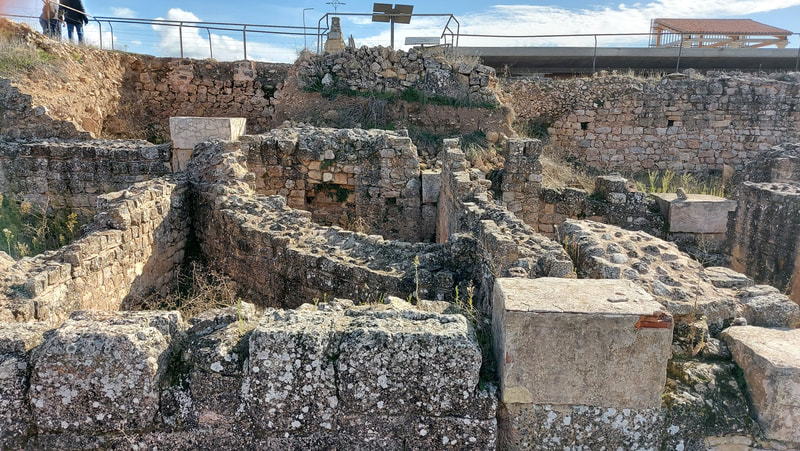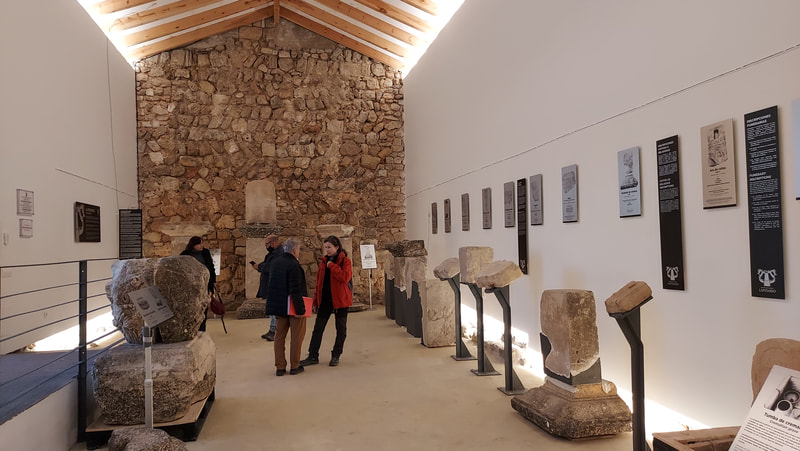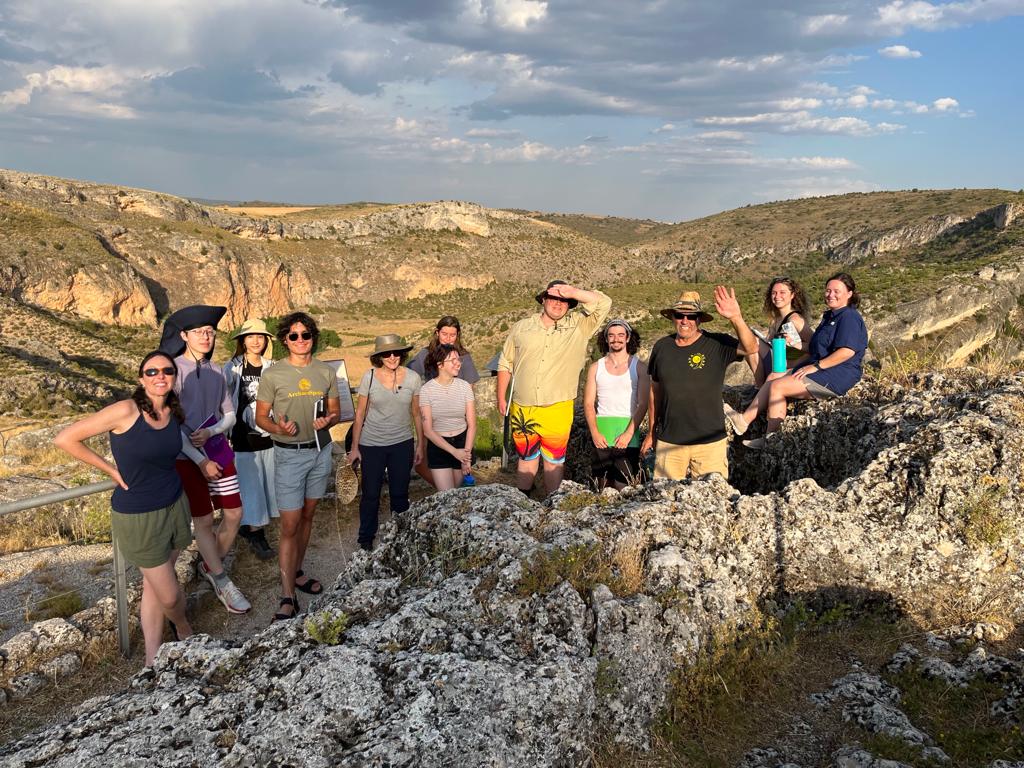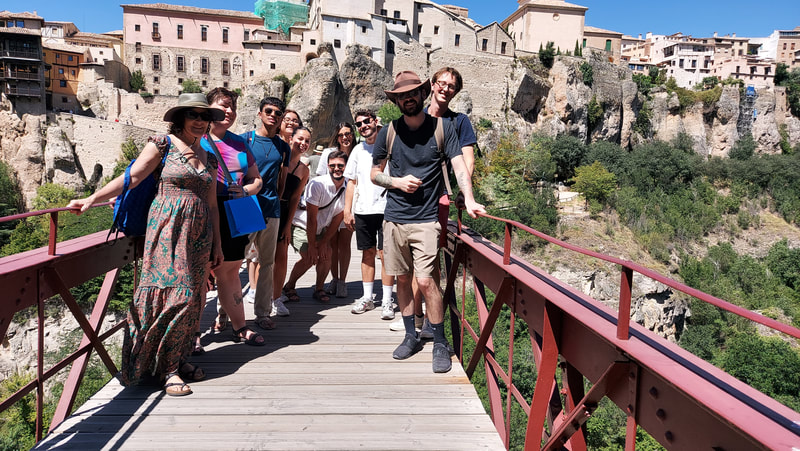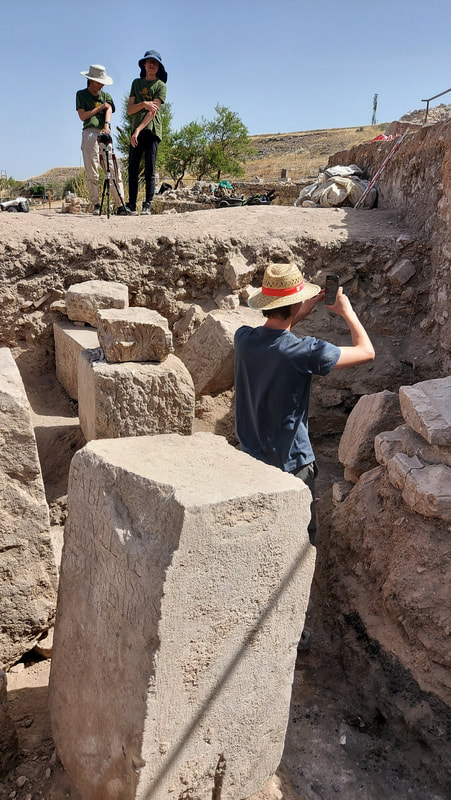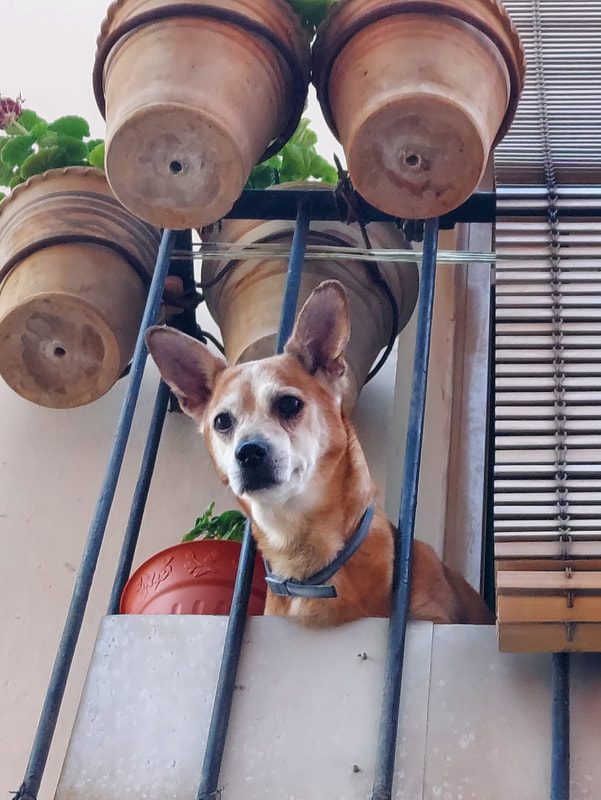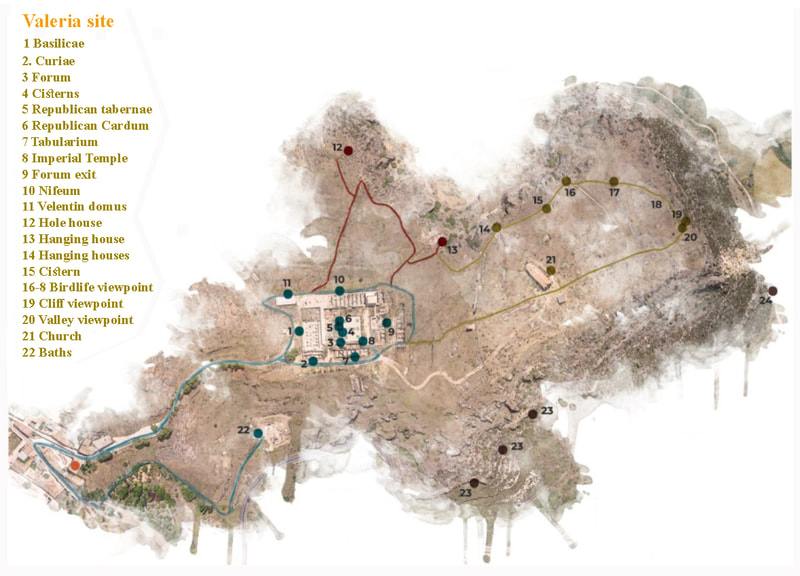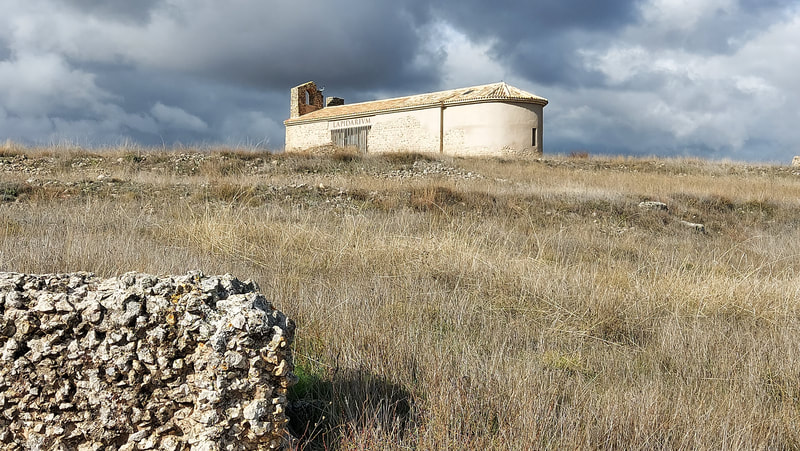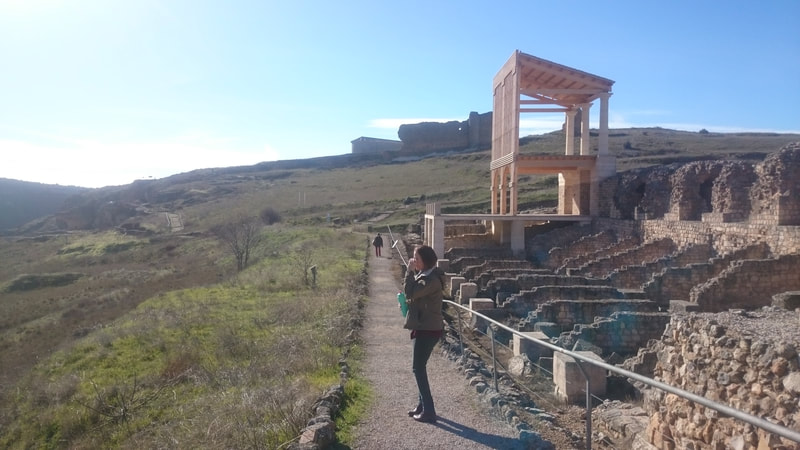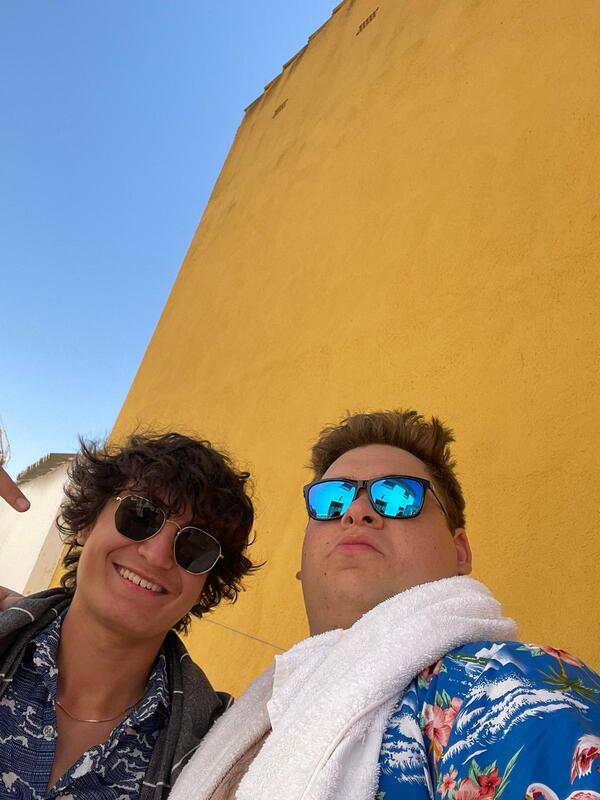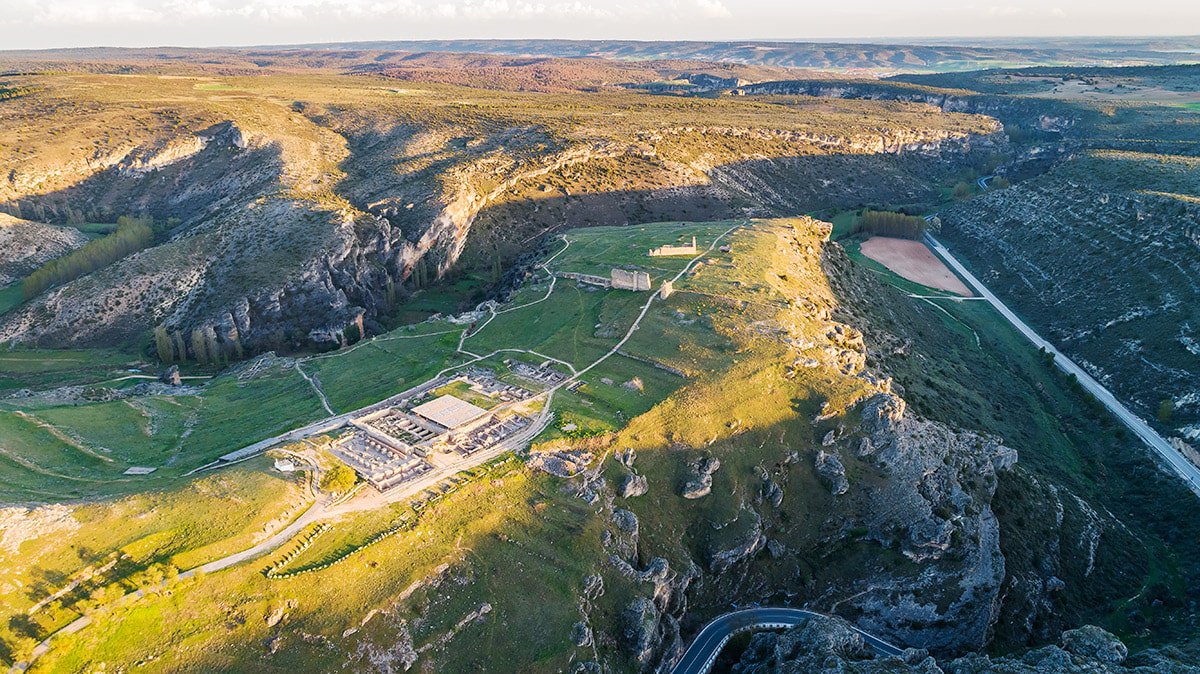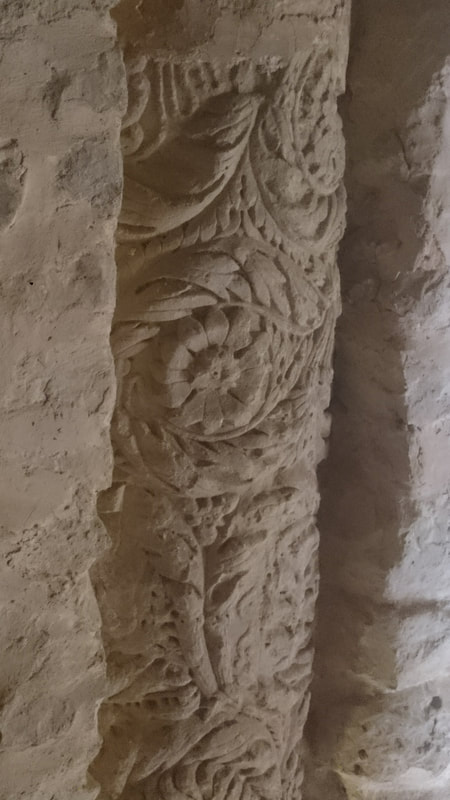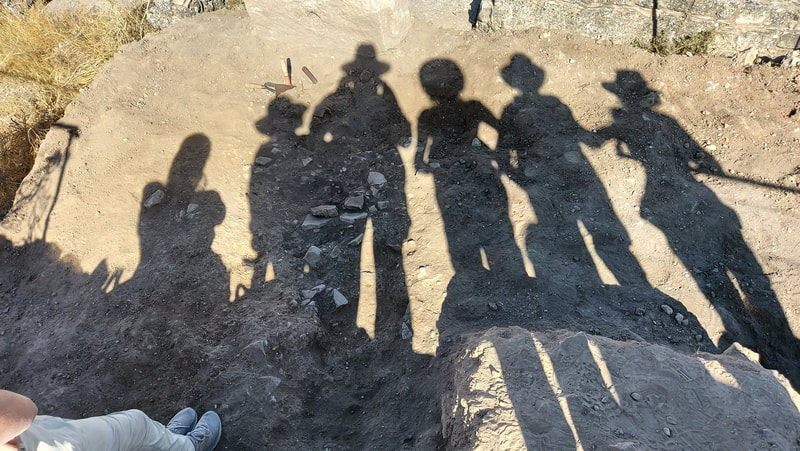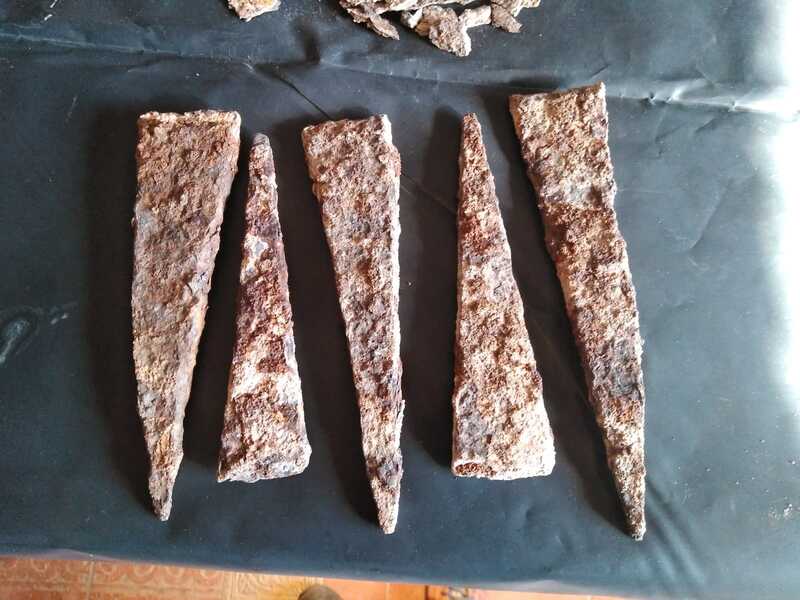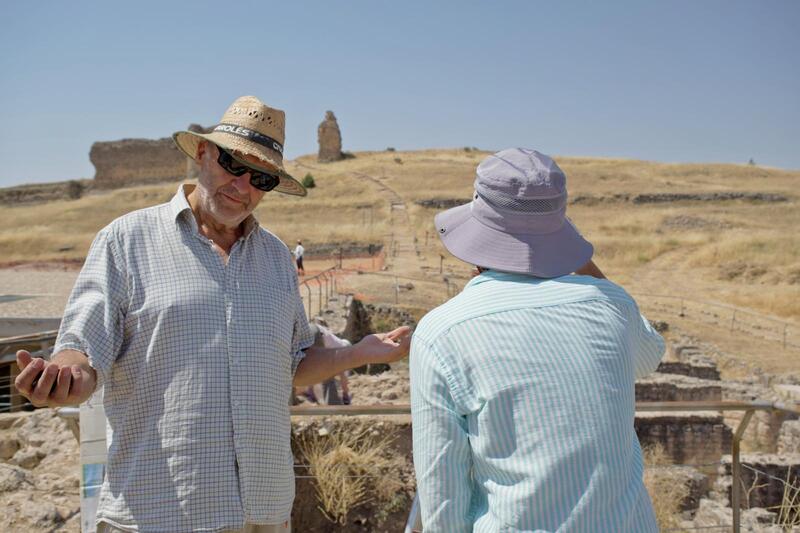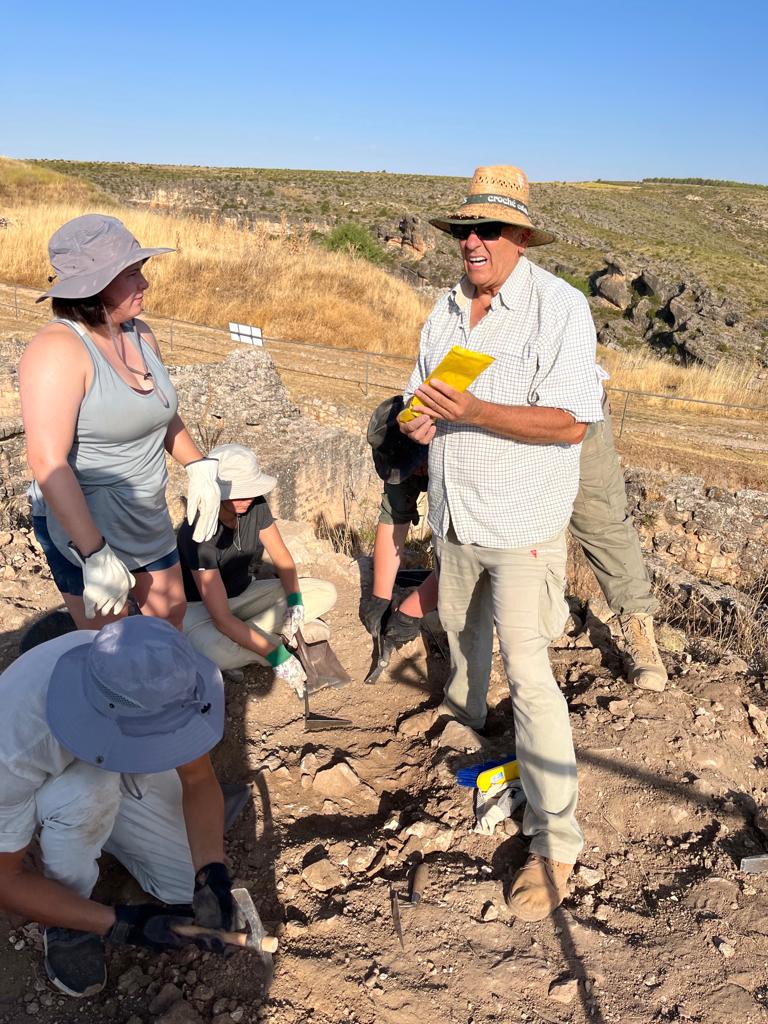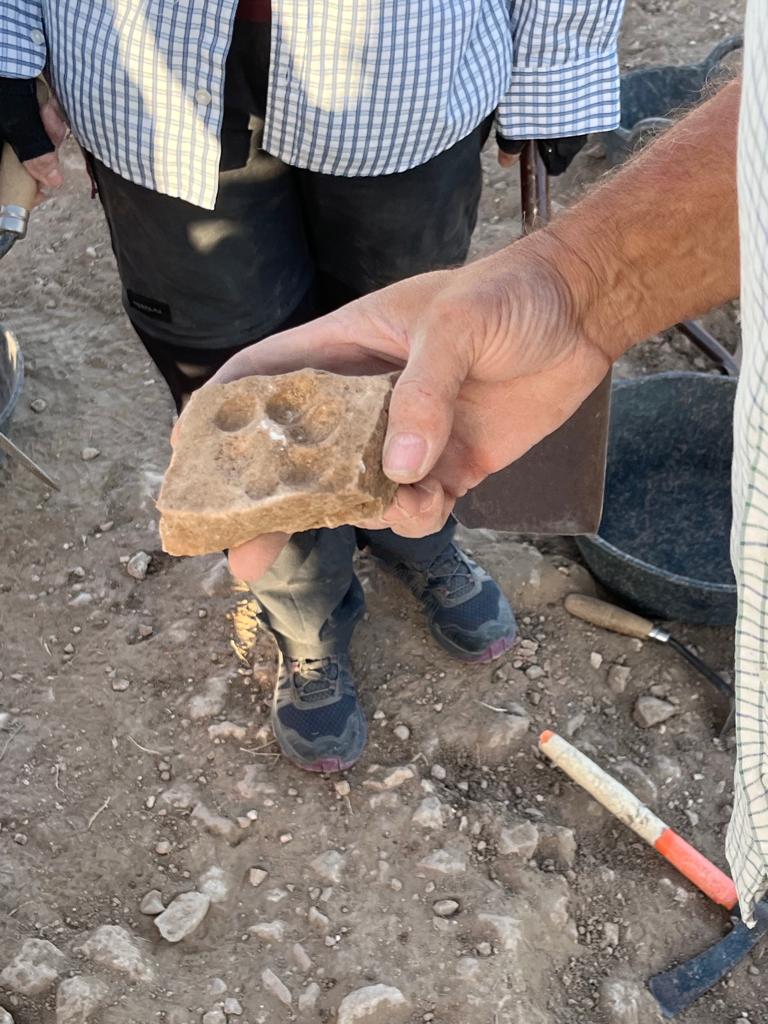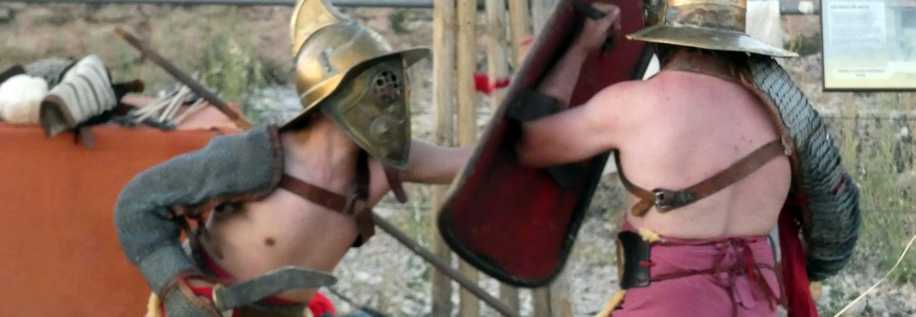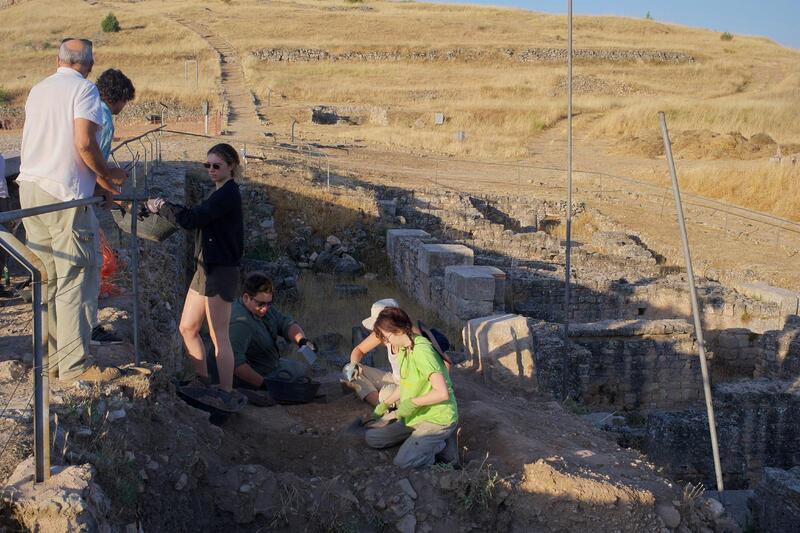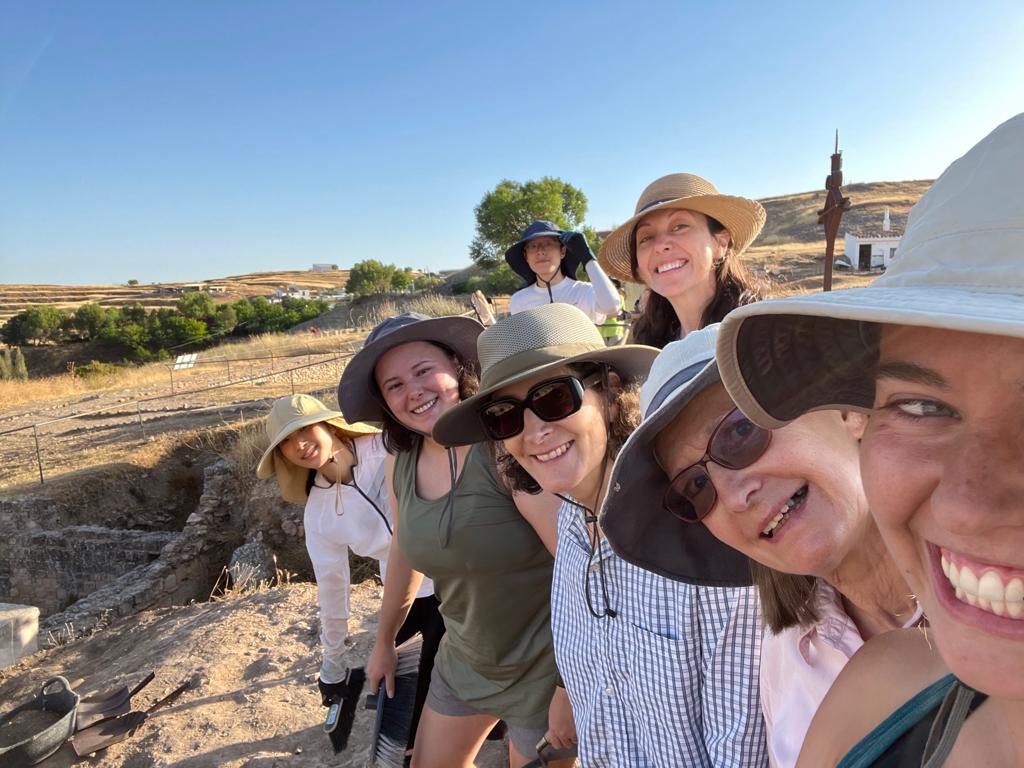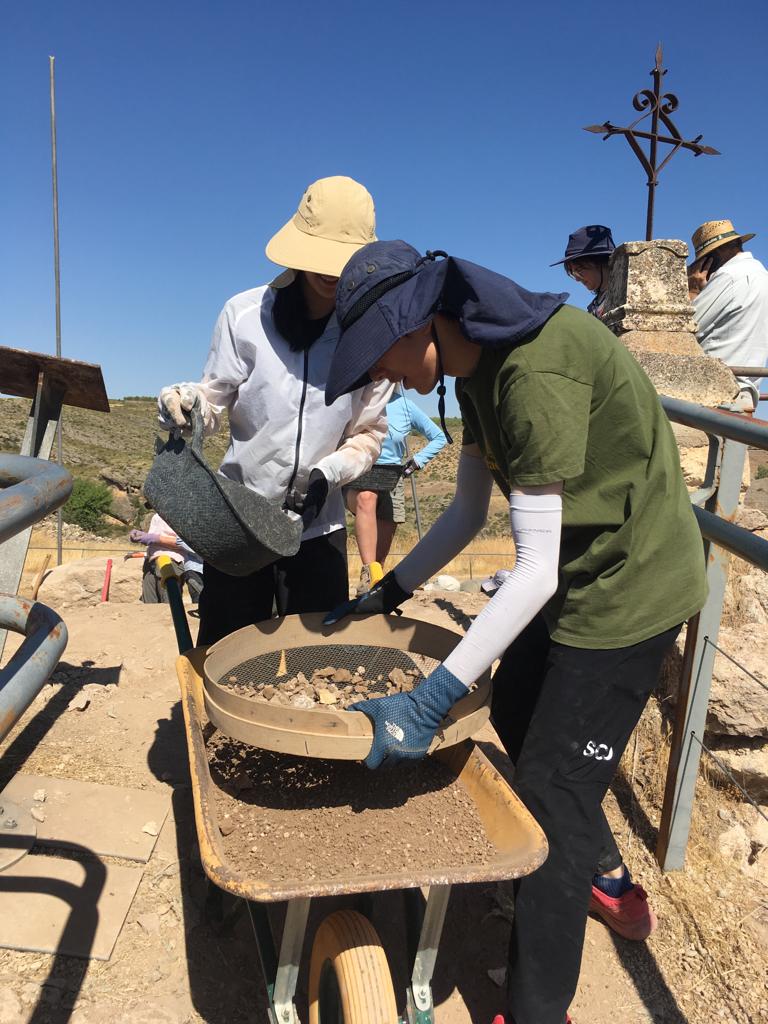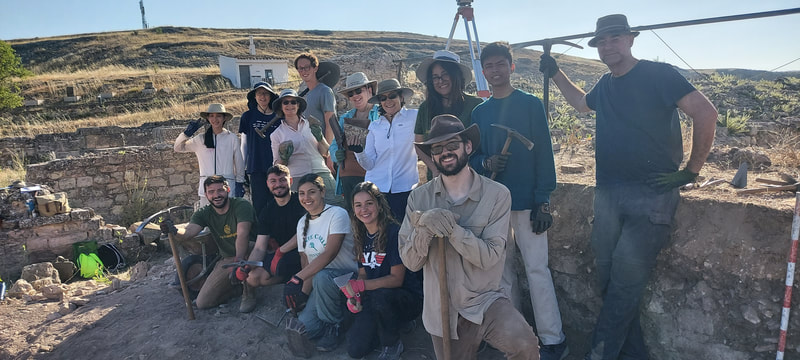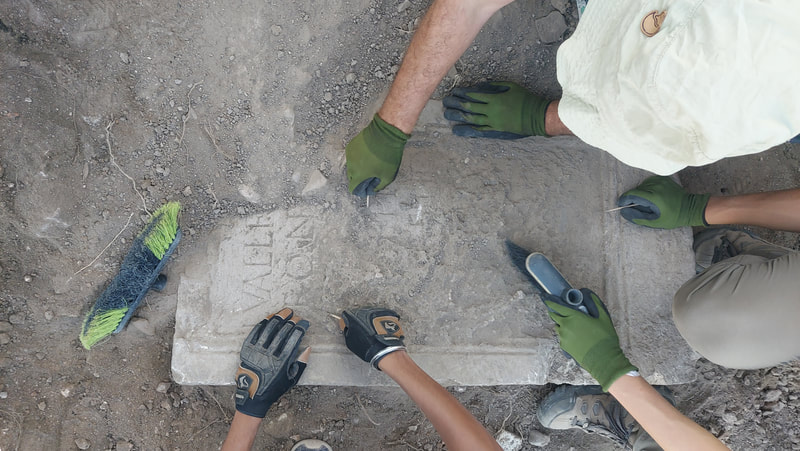|
|
| ||||||||||||||
|
Carthaginem conveniunt populi LXV...the following towns, enjoying the rights of ancient Latium:.. and the Valerienses. Pliny the Elder. Natural History, 3-25.
The Roman city of Valeria is located in central Spain, to the south of the city of Cuenca in the area called Sierra Alta. It was founded between 93-82 BC by the proconsul Gaius Valerius Flaccus, who put down the last revolts of the indigenous Celtiberians. Given the unstable climate at the time, the city was planed and constructed on a narrow plateau very well defended, between two streams with high cliffs . Valeria was also planned within the Roman program of colonization of the interior of the Iberian Peninsula, as one of the romanized setlements that were to become administrative, economic and commercial centers of a new region. |
New place available (male)
| ||||||
The imposing gorge of the river Gritos sculpts and shapes the landscape around Valeria. Deep limestone canyons modeled by the action of the water, varied vegetation in which thyme and rosemary groves alternate with communities of black juniper or poplar and poplar groves, specimens of peregrine falcon, Bonelli's eagle or eagle owl make up a unique natural catalog that will delight all nature or adventure sports lovers.
Valeria’s splendor spans from the time of Augustus to the Flavians. It was at his time when a building program was designed to give monumentality to the heart of the city. Numerous vestiges of it’s earliest moments are also preserved, including part of the Republican forum and some of its outbuildings. As the orography of the chosen place for the city was very irregular, in order to obtain a sufficiently flat, horizontal space, suitable to hold a big square, it was necessary to create a large artificial terrace in the narrowest part of the peninsula. For this purpose, four retaining walls were erected on the spot designed for the forum . On the west side a temple for the emperor cult was constructed, and in the east wing a colonnade of 86m long, and taking advantage of the unevenness of the ground, a nymphaeum and another portico oriented to the outside were placed under the colonnade. Under the nymphaeum we can still see an alignment of tabernae. In the rest of the space around the forum there are public and administrative buildings such as the curia, the basilica or the tabularium.
The Forum was the administrative, political and religious center of the city. It was formed by a large arcaded square around which the main public buildings were distributed. It was well paved and this pavement was covering 4 large water cisterns. The remodeling of the forum took place in the time of the emperors Tiberius, Caligula and Claudio, ending roughly between 20 and 50 AD.
The four cisterns in the center of the Forum were covered by barrel vaults and are an exemplary example of Roman hydraulic engineering. Its walls are made of opus caementicium, the floor has a quarter-round molding at the juncture with the wall in order to facilitate cleaning and prevent leaks. The water was distributed through lead pipes, fistulae plumbae.
The four cisterns in the center of the Forum were covered by barrel vaults and are an exemplary example of Roman hydraulic engineering. Its walls are made of opus caementicium, the floor has a quarter-round molding at the juncture with the wall in order to facilitate cleaning and prevent leaks. The water was distributed through lead pipes, fistulae plumbae.
The basilica is located to the north of the Forum and also underwent extensive renovations, changing its archaic appearance of double portico for a central nave and a perimeter ambulatory. The interior decoration of this space was made of stuccoes and limestone slabs, with ornaments and moldings.
The Tabernae were located on the south, east and west side of the Forum. They were premises dedicated to commercial uses with a regular floor plan, with a large doorway, which were usually covered with a barrel vault and had a window above it to let light into a wooden attic that was used for storage. They were open to the main roads of the city.
The height of the Forum over the area, allows the layout of cryptoporticus to extend its surface to the West and a monumental entrance with a staircase to the South.
The Tabernae were located on the south, east and west side of the Forum. They were premises dedicated to commercial uses with a regular floor plan, with a large doorway, which were usually covered with a barrel vault and had a window above it to let light into a wooden attic that was used for storage. They were open to the main roads of the city.
The height of the Forum over the area, allows the layout of cryptoporticus to extend its surface to the West and a monumental entrance with a staircase to the South.
The hillside falls abruptly on this side of the Forum and it was necessary to build a very high retaining wall, which could have compromised its aesthetic appearance. Therefore the designer of the forum took advantage of this wall and created a shrine to thewater gods, typical in the celtibérian world, that covered the first half of the hight. Under the fountain, covering the lower part of the wall, a line of shops were built. Their roofs served as part of an elongated terrace at a lower level from the Forum. This way of taking advantage of the difficult orography, provided the city with a large balcony over part of the streets and over one of the beautiful clifts.
|
The roman town of Valeria. Site Tours:
The Forum The Ninfaeum The Thermae The Lapidarium Presentations: Hispania romana The roman Civitates The forum in the roman towns The water system of Valeria Roman construction techniques Ornamental arquitecture |
Daily Schedule
6.30 am Breakfast 6.30-10.30 am Excavation 10.30-11 am Snack break 11.00 am-1.30 pm Excavation 2 pm Lunch 3-6 pm Free time 6-8 pm Workshops/Presentations/Site tours/Working with finds 8.30 pm Dinner |
excavation
|
From 1951 to 1974 the archaeological excavations began. The people of the modern small village of Valeria became actively involved, putting an end to the plundering of the site, and the Roman city of Valeria started to be known in various forums and congresses. A Local Museum was also created in 1952, which would be the germ of the Archaeological Museum of Cuenca. From 1974 to 1978, the excavations at Valeria were greatly promoted under the direction of Manuel Osuna. From 1979 the new director was Ángel Fuentes. During this period, works continued in the Forum: the Basilica, until its total excavation and the site of the Curia. The tabernae of the side of the Nymphaeum were excavated to the end, the cave dwelling known as "hanging house" was cleaned and the Cryptoporticus started to be investigated. Two good examples of private urbanism were also exposed; The Casa del Hoyo and the House of the Adobe.
The Roman city had a good water supply through an articulated system of aqueducts, part of them are still visible, carved into the rock. The objects found at this site are in the museum of Cuenca, including the treasure of Valeria consisting of silver coins dating from the period after the Second Punic War in about 185 BC. |
Baths. The Roman baths of Valeria were discovered in 2014/15, on the northern slope of the forum. They date back to the 1st century and fell into disuse in the 3rd century. The complex covered more than 1000 square metres, of which about 250 have been excavated. An arcaded palestra with columns, a swimming pool, a room with a polychrome mosaic and a room with a marble floor have been uncovered. The walls were covered with marble. Numerous ceramic remains, marble, cornices, ironwork, stucco and between 30,000 and 40,000 tesserae have been found.
The frigidarium or cold room was paved with polychrome and geometric mosaics. Archaeological excavations have exhumed the structures belonging to two different rooms: a western room, the frigidarium or cold room, and an oriental room paved with polychrome and geometric mosaics. The frigidarium, excavated almost entirely, has, on the western side, a natatio or indoor pool with a series of steps or benches attached to the northern and southern flanks. The excavation of these rooms has recovered about a thousand marble pieces of different typologies and provenances that were part of both the paving and parietal coatings, as well as abundant remains of mosaics and wall paintings that show the decorative richness of this space.
The frigidarium or cold room was paved with polychrome and geometric mosaics. Archaeological excavations have exhumed the structures belonging to two different rooms: a western room, the frigidarium or cold room, and an oriental room paved with polychrome and geometric mosaics. The frigidarium, excavated almost entirely, has, on the western side, a natatio or indoor pool with a series of steps or benches attached to the northern and southern flanks. The excavation of these rooms has recovered about a thousand marble pieces of different typologies and provenances that were part of both the paving and parietal coatings, as well as abundant remains of mosaics and wall paintings that show the decorative richness of this space.
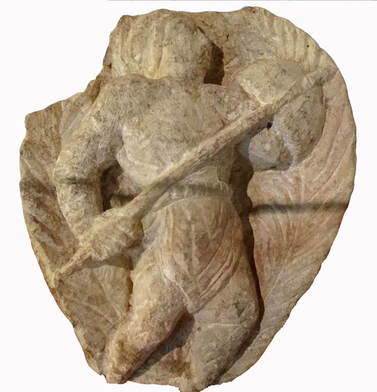
Goals for 2024
In the previous excavation campaigns in Valeria: 2022-23, numerous discoveries have been made, like fragments of sculptures, pedestals with inscriptions, among which are those dedicated by Gaius Grattio Nigrino, Lucio Valerio Proculo and Lucio Fulvio Crassus. A fragment of a bronze torch founded in 2022 can be attributed to the goddess Ceres, a divinity whose statue would stand out among thefigures of the local elites and the characters of the imperial family in this part of the forum. Numerous decorative architectural elements also appear, such as fragments of bases, shafts and column capitals. Two of these capitals are especially important, one of them is Corinthian, most likely from the time of Augustus. Small bronzes have also been found such as a writing style or a bowl to fill with oil the oil lamps o lucernae , a fragment of a small sculpture with the representation of the birth of Venus, rings, bracelets, hair pins, game chips, etc.
In the previous excavation campaigns in Valeria: 2022-23, numerous discoveries have been made, like fragments of sculptures, pedestals with inscriptions, among which are those dedicated by Gaius Grattio Nigrino, Lucio Valerio Proculo and Lucio Fulvio Crassus. A fragment of a bronze torch founded in 2022 can be attributed to the goddess Ceres, a divinity whose statue would stand out among thefigures of the local elites and the characters of the imperial family in this part of the forum. Numerous decorative architectural elements also appear, such as fragments of bases, shafts and column capitals. Two of these capitals are especially important, one of them is Corinthian, most likely from the time of Augustus. Small bronzes have also been found such as a writing style or a bowl to fill with oil the oil lamps o lucernae , a fragment of a small sculpture with the representation of the birth of Venus, rings, bracelets, hair pins, game chips, etc.
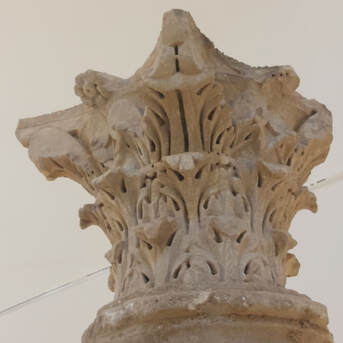
In 2024 excavations will continue to focus on this part of the western cryptoporticus. After discovering in 2023 the first signs of the original pavement of the cryptoportic, formed by a clear level of ashes, the excavations will focus on the excavation of the lower levels in which the presence of a set of imitation indigenous and earthen ceramics seems to be confirmed. sigillata, which could serve to accurately date one of the last moments of use of the cryptoporticus. On the other hand, the investigation will continue to the north of the cryptoporticus in order to fully locate the set of architectural elements that were part of this area of the forum, known as the Exedra, which thanks to the new findings can be interpreted as as a space for the representation of the elites is proposed, following the model of Augustus in the forum of Rome.
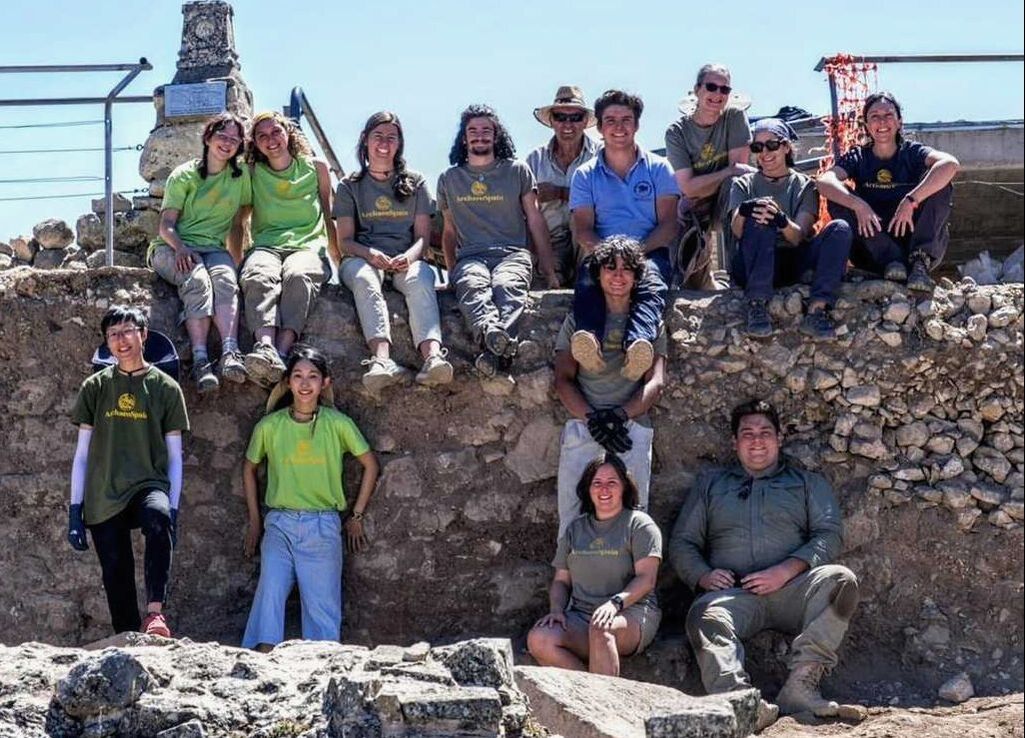
accommodation
Valeria is a small municipality in the middle mountains of Cuenca with barely 80 inhabitants. Its urban area is structured around the Plaza Mayor, where we find the church, the Town Hall and some interesting mansions such as the house of the Curato and the house of the Dukes of Granada.
From the square you can see the Town Hall building, which dates from the 18th century, has a rectangular floor plan and two floors.
The church of Nuestra Señora de la Sey, which was the seat of the Visigoth bishopric, stands out among the buildings in Valeria. The Visigothic seat was probably built over an ancient Roman temple of which the Airón well was preserved, and later, in the 12th and 13th centuries, the Romanesque temple was built, with three naves and three apses, unique in the province. And in the 16th and 17th centuries it was modified again, obtaining its current appearance. On its walls we can see Roman columns and funerary stelae, Visigothic pieces, or its Mudejar roof.
Attached to the church on the north side are the sacristy and the Parish Museum. This museum is of great value for housing, among others, artistic treasures such as: Baroque canvases, a Mudejar coffered ceiling, Roman funerary stelae, construction elements of Visigothic origin and an altar front made of Talavera tiles. A museum has recently been installed in the site's old medieval church, with decorative construction pieces and epigraphs.
The team will be staying in two traditional guest houses in the little town. We will be able to enjoy not only our double rooms but the comon spaces like the dinning rooms, the kitchen and the patios with barbecue. They are the perfect space to rest and hang out with our new friends.
Meals: Breakfast will be provided at our accommodations, and we will all take turns setting it up along with the snak for the site. A fix menu will be cooked for lunch and dinner at a local restaurant.
From the square you can see the Town Hall building, which dates from the 18th century, has a rectangular floor plan and two floors.
The church of Nuestra Señora de la Sey, which was the seat of the Visigoth bishopric, stands out among the buildings in Valeria. The Visigothic seat was probably built over an ancient Roman temple of which the Airón well was preserved, and later, in the 12th and 13th centuries, the Romanesque temple was built, with three naves and three apses, unique in the province. And in the 16th and 17th centuries it was modified again, obtaining its current appearance. On its walls we can see Roman columns and funerary stelae, Visigothic pieces, or its Mudejar roof.
Attached to the church on the north side are the sacristy and the Parish Museum. This museum is of great value for housing, among others, artistic treasures such as: Baroque canvases, a Mudejar coffered ceiling, Roman funerary stelae, construction elements of Visigothic origin and an altar front made of Talavera tiles. A museum has recently been installed in the site's old medieval church, with decorative construction pieces and epigraphs.
The team will be staying in two traditional guest houses in the little town. We will be able to enjoy not only our double rooms but the comon spaces like the dinning rooms, the kitchen and the patios with barbecue. They are the perfect space to rest and hang out with our new friends.
Meals: Breakfast will be provided at our accommodations, and we will all take turns setting it up along with the snak for the site. A fix menu will be cooked for lunch and dinner at a local restaurant.
dates & fees
Program Dates 2024: July 14-2 August
Fee: US$ 2,650$
Program Fees Include:
Full room and board
Fieldwork training
Excursions and other activities.
Transportation to and from airport on first and last days of the program (participants will be responsible for their transportation if arriving o leaving at a time no scheduled by ArchaeoSpain staff).
Medical Insurance
Application fee
Administrative costs
Certificate of 120h
Part of your fee will go towards the research project.
Fees DO NOT include airfare.
Fee: US$ 2,650$
Program Fees Include:
Full room and board
Fieldwork training
Excursions and other activities.
Transportation to and from airport on first and last days of the program (participants will be responsible for their transportation if arriving o leaving at a time no scheduled by ArchaeoSpain staff).
Medical Insurance
Application fee
Administrative costs
Certificate of 120h
Part of your fee will go towards the research project.
Fees DO NOT include airfare.
PAYMENT PROCESS:
To reserve a space, you must pay a $400 application deposit. (Included in the price of the program).
The remainder of the program cost will be due by April 1st.
Application fees will be refunded if the applicant is not selected.
Application Deadline:
Rolling application. We accept applications until all spaces are filled.
Cancellation and Refund Policy:
-Before March 1st: All payments, except $100 from the application deposit, are refundable.
-Between March 1st and April 1st: Application fee non-refundable. The remaining balance is refundable.
-After April 1st: All payments are non-refundable unless your application is rejected by the program director.
Travel Arrangements:
You should begin making travel arrangements as soon as you are notify of your selection, and you should complete them upon being notified of your selection. We strongly recommend that participants purchase travel insurance to cover all needs including medical, accident, baggage loss, delays and personal liability. ArchaeoSpain is not a travel provider nor is a registered travel agent. Your travel arrangements to and from Spain are subject to the terms and conditions of your travel agency. In the rare event that the program is cancelled, ArchaeoSpain will refund program fees, but is not responsible for non-refundable airline or other tickets or payments or any similar penalties that may be incurred. It is your responsibility to protect yourself against airline and travel agency cancellation fees.
To reserve a space, you must pay a $400 application deposit. (Included in the price of the program).
The remainder of the program cost will be due by April 1st.
Application fees will be refunded if the applicant is not selected.
Application Deadline:
Rolling application. We accept applications until all spaces are filled.
Cancellation and Refund Policy:
-Before March 1st: All payments, except $100 from the application deposit, are refundable.
-Between March 1st and April 1st: Application fee non-refundable. The remaining balance is refundable.
-After April 1st: All payments are non-refundable unless your application is rejected by the program director.
Travel Arrangements:
You should begin making travel arrangements as soon as you are notify of your selection, and you should complete them upon being notified of your selection. We strongly recommend that participants purchase travel insurance to cover all needs including medical, accident, baggage loss, delays and personal liability. ArchaeoSpain is not a travel provider nor is a registered travel agent. Your travel arrangements to and from Spain are subject to the terms and conditions of your travel agency. In the rare event that the program is cancelled, ArchaeoSpain will refund program fees, but is not responsible for non-refundable airline or other tickets or payments or any similar penalties that may be incurred. It is your responsibility to protect yourself against airline and travel agency cancellation fees.
Medical Insurance:
All ArchaeoSpain participants are covered with an insurance packet that provides medical and surgical treatment and prescription drugs in case of accident or sudden illness.
European students should bring an EHIC card with them.
Right of Refusal:
ArchaeoSpain reserves the right to refuse an applicant’s selection. This is a rare occurrence and is most likely due to a person’s inability to meet health requirements or in the interest of group compatibility. Once in the field, the program director and ArchaeoSpain reserve the right to send a participant away from the program should that person’s behavior compromise the safety, research objectives and general performance of the group, or violate the Spanish laws, regulations or customs.
the staff
SITE DIRECTORS
|
Dionisio Urbina
PhD from the University Complutense of Madrid. He has been a professional archaeologist since 1990 and has directed over fifty archaeological excavations: Medieval, Late Antique, Roman, Iron and Bronze Age. Specialist in the Roman world and the Second Iron Age in the center of the Iberian Peninsula, he has published several scientific articles and divulgative books, co-edited several conferences and exhibition catalogs, and several articles in scientific journals. Catalina Uquijo Álvarez de Toledo
She has been a professional archaeologist for over 25 years, has directed more than twenty archaeological excavations, from Bronze Age to Medieval times. She has taught numerous courses and archaeological exhibitions, and is the author of several books and numerous scientific articles. |
As part of one of Archaeospain's programs, you agree to respect the archaeological sites and monuments in accordance with the laws of each country, and to accept the code of ethics that does not allow taking photographs of the archaeological sites or of the discoveries made in them. The publication of photographs related to the sites and their findings, especially on social media, need always the prior approval of the directors of the archaeological sites.
excursions
Day excursion to Toledo, declared World Heritage City, is a very unique place. It is known as the city of the three cultures: Muslim, Christian and Jewish. You will have the opportunity to visit some examples like the mosque of the Cristo de la Luz, the synagogue of The Tránsito or the Cathedral of Toledo. We’ll get lost in its narrow streets, have tapas at its terraces and we will also have time for some shopping.
Cuenca, Built by the Moors in a defensive position at the heart of the Caliphate of Cordoba, Cuenca is an unusually well-preserved medieval fortified city. Conquered by the Castilians in the 12th century, it became a royal town and bishopric endowed with important buildings, such as Spain's first Gothic cathedral, and the famous casas colgadas (hanging houses), suspended from sheer cliffs overlooking the Huécar river. Taking full advantage of its location, the city towers above the magnificent countryside. city. The old city was designated a UNESCO World Heritage site in 1996. The Romanesque-Gothic cathedral (13th century) is notable, and the city is the site of the Provincial Archaeological and Spanish Abstract Art museums.
The Roman City of Segóbriga was the cultural, administrative and miner centre of a wide area in the heart of Spain. Plinius the Elder called it “caput celtiberiae”. The city was founded by Iulius
Caesar and thanks to the wealth due to the exploitation of lapis specularis mines in times of Augustus, an ambitious program of public constructions began: a great foro, the theatre, amphitheatre, termae, temples, and circus.
Caesar and thanks to the wealth due to the exploitation of lapis specularis mines in times of Augustus, an ambitious program of public constructions began: a great foro, the theatre, amphitheatre, termae, temples, and circus.
Rio Gritos and Pico de la Muela site.
The Gritos river gorge was the natural access road to Valeria from the south and SE. We will take a morning walk contemplating the rock cliffs of the canyon. At the end we will arrive at the foot of the Pico de la Muela peninsula, an Iron Age site prior to the Roman Valeria. In the afternoon we will enjoy the pool in Valera de Abajo.

